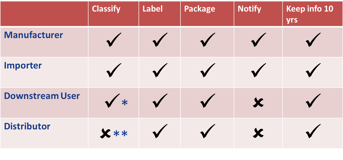Roles and Duties

What a company needs to do to comply with CLP will depend on their role and where they sit in the supply chain. The information provided here gives an overview of the different roles a company might have and what that means in terms of CLP responsibilities. All ‘actors’ in the supply chain have a responsibility to ensure that they identify the hazards of substances and mixtures, and that they communicate this information using labelling and safety data sheets in accordance with CLP and REACH Regulations respectively, including for online sales. Obligations are determined by the role of the actor in the supply chain: be it a manufacturer, importer, downstream user, distributor or producer of articles.
*If DU changes composition, must classify. If not, use classification other actor
**Distributer may use classification of another actor
Manufacturer / Importer
- All substances and mixtures must be classified, labelled and packaged according to CLP before placing them on the market by the manufacturer or importer.
- All substances subject to registration or notification in line with Articles 6, 9, 17 or 18 of the REACH Regulation, must also be classified by the manufacturer or importer.
- If any new scientific or technical data become available following classification, the manufacturer or importer must re-evaluate the classification and update the label accordingly.
- Classification and labelling elements must be notified to the classification and labelling inventory for substances placed on the market.
Downstream User (incl. Formulators)
All substances and mixtures must be classified, labelled and packaged according to CLP before placing them on the market, however the downstream user may use the classification derived by another actor in the supply chain, provided that the composition is unchanged. The downstream user must derive his own classification in accordance with CLP, where the composition has been changed.
Distributor (incl. Retailer)
All substances and mixtures must be labelled and packaged according to CLP before placing them on the market, however the distributors may use the classification derived by another actor in the supply chain, for example from a safety data sheet.
Producers of Articles
- Importers and producers of explosive articles (in accordance with section 2.1 of Annex I to CLP) must classify, label and package in accordance with CLP before placing on the market.
- Importers and producers of articles should classify substances in accordance with CLP that are not placed on the market but subject to registration or notification under REACH (Articles 7(1), 7(2), 7(5) or 9).
All
- If any new scientific or technical data become available following classification, the manufacturer, importer or downstream user must re-evaluate the classification and update the label accordingly.
- If an actor has any new information that could lead to a change of harmonised classification and labelling elements of a substance, a proposal should be submitted to a member state competent authority from one of the member states where the substance is placed on the market.
- All information required for the purposes of classification and labelling under CLP must be available for a period of at least 10 years after last supply of the substance or mixture.
Further information
HSA: Chemical Importer Information Sheet
HSA: Information for Retailers on Hazard Labelling and Packaging of Chemical Products
ECHA: Downstream users
